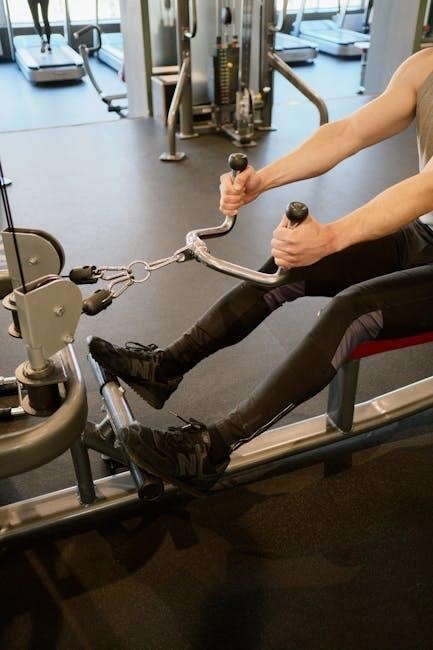The Colorado Experiment: An Overview
The Colorado Experiment was a high-intensity training study conducted in 1973 by Arthur Jones using Nautilus equipment․ The experiment aimed to demonstrate the effectiveness of short, intense workouts for rapid muscle growth and fat loss․ It gained notoriety due to Casey Viator’s reported results․
The Key Figures: Arthur Jones and Casey Viator
The Colorado Experiment was spearheaded by Arthur Jones, the inventor of Nautilus machines and a proponent of high-intensity training (HIT)․ Jones sought to revolutionize bodybuilding by promoting shorter, more effective workouts using his innovative equipment․ His goal was to prove that less frequent but intense training could yield superior results compared to conventional, longer training sessions․
Casey Viator, a young and promising bodybuilder, was chosen by Jones to be the subject of the experiment․ Viator had already achieved considerable success in bodybuilding and was considered a prime candidate to showcase the potential of Jones’s training methods․ He was the perfect subject to carry out the Colorado Experiment․
Viator’s dedication and Jones’s expertise formed a partnership designed to push the boundaries of physical training and muscle development․ Their collaboration became iconic in the bodybuilding world․

The Workout Routine: High-Intensity Training (HIT)
The Colorado Experiment centered around High-Intensity Training (HIT), a method championed by Arthur Jones․ HIT emphasizes performing each set to complete muscular failure, maximizing muscle fiber recruitment in minimal time․ Workouts were brief but extremely demanding, focusing on controlled movements and proper form․ The core principle was to stimulate muscle growth through intense effort rather than prolonged duration․
Each exercise was performed with a slow, deliberate cadence, emphasizing both the concentric (lifting) and eccentric (lowering) phases of the movement․ Rest periods between sets were kept short to maintain a high level of intensity․ This approach challenged the traditional bodybuilding belief that volume and frequency were paramount for muscle growth․
Negative-only reps were incorporated into some exercises․ This added intensity enhanced muscle stimulation․
Nautilus Machines: The Core Equipment
The Colorado Experiment heavily relied on Nautilus machines, invented by Arthur Jones․ These machines were designed to provide variable resistance throughout the entire range of motion, better matching the strength curve of the muscles being worked․ This variable resistance aimed to maximize muscle fiber recruitment and stimulation, leading to more efficient and effective workouts․
Nautilus equipment offered a safer and more controlled environment compared to free weights, allowing for greater focus on proper form and intensity․ The machines also enabled precise tracking of progress, which was crucial for monitoring the experiment’s results․ Jones believed that Nautilus machines were superior for building muscle mass quickly and safely․
The unique design of Nautilus machines played a crucial role in the experiment’s emphasis on high-intensity, low-volume training․
Experiment Timeline and Structure
The Colorado Experiment was a focused, short-term study, lasting only 28 days․ This compressed timeline was designed to test the efficacy of high-intensity training using Nautilus equipment․ The structure involved specific workout protocols and meticulous data collection․
Duration: 28 Days
The Colorado Experiment’s duration was strictly limited to 28 days, a key factor in its design․ This focused timeframe allowed for intense observation and data collection regarding the effects of high-intensity training․ The relatively short duration was meant to demonstrate that significant muscle growth and fat loss could be achieved rapidly with the correct training protocol․ Jones believed that longer training periods were unnecessary and could even be counterproductive․
The experiment’s design aimed to maximize results within the 28-day window, challenging conventional bodybuilding wisdom that emphasized longer, more frequent workouts․ This time constraint underscored the efficiency and effectiveness of the high-intensity approach, making the results all the more remarkable and controversial․ The limited duration also helped maintain strict control over the experimental variables․
Workout Frequency: 3 Days Per Week
The Colorado Experiment adhered to a workout frequency of only three days per week, a departure from typical bodybuilding routines․ This low-frequency approach was central to Arthur Jones’ high-intensity training philosophy․ Jones advocated for allowing ample recovery time between workouts to maximize muscle growth․ Each workout was designed to be extremely demanding, pushing the muscles to their absolute limit․
The three-day-per-week schedule ensured that Casey Viator had sufficient rest to repair and rebuild muscle tissue․ This recovery period was considered just as crucial as the workouts themselves․ By minimizing the frequency of training sessions, the experiment aimed to optimize the body’s adaptive response, leading to greater gains in strength and muscle mass within the 28-day period․ This challenged the conventional wisdom of more frequent training․
Workout Length: Approximately 30 Minutes
Each workout session in the Colorado Experiment was remarkably brief, lasting only approximately 30 minutes․ This short duration was a key component of Arthur Jones’ High-Intensity Training (HIT) approach․ The focus was on maximizing effort and intensity within a minimal timeframe․ This challenged the conventional belief that longer workouts were necessary for muscle growth․
The condensed workout length emphasized quality over quantity, with each exercise performed to complete muscular failure․ The goal was to stimulate maximum muscle fiber recruitment in the shortest possible time․ This efficient approach allowed for ample recovery between sessions, promoting optimal muscle growth and minimizing the risk of overtraining․ Jones believed in brief, infrequent and intense workouts․
Viator’s Reported Gains: Muscle and Fat Loss
Casey Viator reportedly experienced significant gains during the Colorado Experiment․ These gains included substantial muscle mass increase and a notable reduction in body fat; The experiment aimed to showcase the potential for rapid body composition changes․
Muscle Gain: 63․21 lbs
Casey Viator’s most remarkable result from the Colorado Experiment was the reported gain of 63․21 pounds of muscle mass․ This substantial increase occurred over a short 28-day period․ Viator gained this weight from only 14 workouts․ Each workout was 33․6 minutes․ This result quickly captured attention, and generated lots of talking for over 40 years, and fueled debate regarding the efficiency of high-intensity training․ Critics questioned the accuracy and sustainability of such rapid muscle growth․ It challenged conventional bodybuilding wisdom that favored longer, more frequent workouts․
Such rapid muscle growth remains a controversial topic in exercise science․
Fat Loss: 17․93 lbs
Alongside the impressive muscle gain, Casey Viator also reportedly experienced a significant reduction in body fat during the Colorado Experiment․ The documented fat loss was 17․93 pounds over the 28-day period․ This combination of muscle gain and fat loss is significant․ It showcased the potential of the high-intensity training․ However, it also raised questions about the accuracy of body composition measurements․ A loss of 17․93 lbs of fat in 28 days is impressive․ It’s important to remember that this was under very specific circumstances, with close supervision from Arthur Jones․ The Colorado Experiment’s diet and training was very strict․
Sample Exercises and Rep Ranges
The Colorado Experiment employed a variety of exercises, primarily using Nautilus machines, to target different muscle groups․ Sample exercises included the leg press, squat, standing press, and pullovers․ Rep ranges varied, but were generally in the range of 8-15 repetitions․ High intensity was emphasized․ Some exercises even incorporated negative-only reps․ The specific rep ranges were adjusted based on the individual’s strength and fatigue levels․ The aim was to achieve muscular failure within the prescribed rep range․ Heavy weights were combined with controlled movements to maximize muscle stimulation․ The focus was on quality over quantity․ The exercises were varied by Arthur Jones․

Controversies and Criticisms Surrounding the Experiment
The Colorado Experiment, while groundbreaking, faced numerous controversies and criticisms․ One major point of contention was the skepticism surrounding Viator’s reported muscle gain of 63․21 lbs in just 28 days․ Critics argued that such rapid muscle growth was physiologically improbable, even with intense training and optimal nutrition․ Some suggested that Viator’s previous steroid use might have influenced the results․ The lack of scientific rigor and control in the experiment’s design was also a concern․ The limited sample size and absence of a control group made it difficult to generalize the findings․ The experiment lacked comprehensive documentation․ These factors cast doubt on the validity of the results․

Influence on Modern Training Methods
Despite the controversies, the Colorado Experiment significantly influenced modern training methods․ The emphasis on high-intensity training (HIT) principles, short workout durations, and infrequent training sessions gained traction․ HIT advocates adopted the experiment’s focus on pushing muscles to momentary muscular failure․ This approach challenged the conventional wisdom of high-volume training․ Many modern training programs incorporate elements of HIT, such as slow, controlled movements and negative-only reps․ The experiment spurred interest in efficient, time-saving workout routines․ The Colorado Experiment influenced the development of various training philosophies․ It highlighted the importance of intensity and recovery․ It continues to inspire bodybuilders․

The Colorado Experiment Workouts (PDF)
For those interested in delving deeper into the specifics of Casey Viator’s training, a compiled PDF containing the Colorado Experiment workouts can be a valuable resource․ This document often includes a detailed breakdown of each workout session, including the exercises performed, the rep ranges used, and any specific notes or observations made during the experiment․ Accessing this PDF allows individuals to examine the exact routine followed by Viator, providing insights into the application of high-intensity training principles․ It serves as a comprehensive guide for those looking to understand or potentially implement similar training methodologies․ The PDF offers a structured view of Viator’s workouts․

No Responses